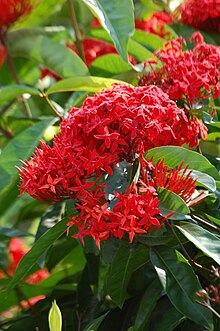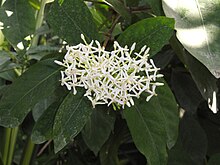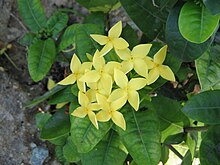Ixora
| Ixora | ||||||||||||
|---|---|---|---|---|---|---|---|---|---|---|---|---|

Variety of Ixora coccinea |
||||||||||||
| Systematics | ||||||||||||
|
||||||||||||
| Scientific name of the tribe | ||||||||||||
| Ixoreae | ||||||||||||
| A.Gray | ||||||||||||
| Scientific name of the genus | ||||||||||||
| Ixora | ||||||||||||
| L. |
Ixora is the only genus of the tribe Ixoreae within the plant family of the Rubiaceae (Rubiaceae). The 500 to 560 species are mainly found in tropical areas in Africa , Madagascar , Asia , on Pacific islands and in the Neotropics .
description





Appearance and leaves
Ixora species are evergreen, woody plants that grow as shrubs or small trees . The unreinforced shoot axes are mostly independently upright and only rarely climb ( Ixora hekouensis ).
The leaves, which are mostly opposite or rarely in threes in whorls, are divided into a petiole and a leaf blade. They do not have domatia . The base of the petioles is articulated. The simple leaf blades are shiny, glabrous, and often leathery. The durable until early sloping side leaves are triangular, short fused with acute or begranntem upper end and they can shoot around the axis.
Inflorescences and flowers
On the main stem, zymose or umbrella-like inflorescences that contain a few to many flowers are formed at the end of the stem or sometimes on reduced, leafless side branches . There may be inflorescence stems. The inflorescence axes are often articulated. Cauliflora is present in some species (for example Ixora cauliflora , Ixora margaretae ). The bracts and bracts are reduced; if cover sheets are present, then they are often fused in pairs. There may be flower stalks.
The often fragrant, hermaphrodite flowers are zygomorphic and usually four, rarely five-fold with a double flower envelope . The mostly four, rarely five sepals are fused and the calyx ends truncated or with recognizable calyx teeth. The petals are often white to whitish, yellow to orange and red to pink, they often turn reddish when drying. The mostly four, rarely five up to nine petals are fused together like a saucer; The long, slender corolla tube is bald inside or hairy on the throat. The corolla lobes overlap convolutely in the flower bud and spread out during the anthesis. There are usually four, rarely five stamens ; they are about the same length as the crown or they tower above it. The short or reduced stamens are inserted at the throat of the crown. The disc is thick or thickened. The two-chamber ovary contains only one hanging in each chamber ovule . The thread-like stylus is spindle-shaped to club-shaped in the upper area and usually ends in two linear, back-curved scars that (slightly) protrude over the crown.
Fruits and seeds
The almost spherical to ellipsoidal or egg-shaped drupes are covered by the durable sepals and are leathery or fleshy. The black or red drupes when ripe usually contain two stone pits with one seed each. The stone cores are plano-convex or concavo-concave and have a leathery or parchment-like shell. The seeds are medium in size, ellipsoidal to oblanceolate with a membranous seed coat and a cartilaginous endosperm .
Sets of chromosomes
The basic chromosome number is x = 11, the species examined have diploidy , i.e. 2n = 22.
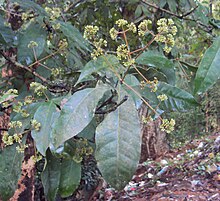


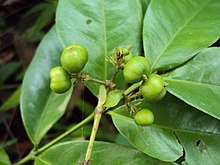
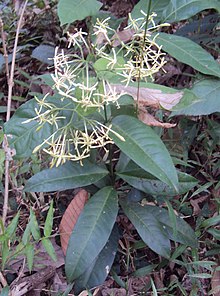
Systematics and distribution
The genus Ixora was set up in Species Plantarum , 1st edition, p. 110 in 1753 . As Lectotypusart was Ixora coccinea L. by Albert Spear Hitchcock in proposals by British Botanists , 1929, determined S. 124th Synonyms for Ixora L. are: Schetti Adans. , Sideroxyloides Jacq. , Patabea Aubl. , Myonima Comm. ex A.Juss. , Siderodendrum Schreb. , Bemsetia Raf. , Panchezia Montrouz. , Charpentiera Vieill. , Hitoa Nadeaud , Versteegia Valeton , Becheria Ridl. , Thouarsiora Homolle ex Arènes , Captaincookia N.Hallé , Doricera Verdc. , Tsiangia But, HHHsue & PTLi .
Ixora is the only genus of the tribe Ixoreae in the subfamily Ixoroideae within the family of Rubiaceae . Molecular genetic studies show that the genus Ixora contains all the most closely related earlier genera to a very large extent.
The genus Ixora is widespread mainly in tropical areas in Africa , Madagascar , Asia , in the Neotropics and on Pacific islands. There are 18 species in China, 9 of them only there.
The genus Ixora now contains 500 to 564 (previously 300 to 400) species:
- Ixora accedens Valeton
- Ixora aciculiflora Bremek.
- Ixora acuminatissima garbage. Arg.
- Ixora acuticauda Bremek.
- Ixora aegialodes Bremek.
- Ixora agasthyamalayana Sivad. & N.Mohanan
- Ixora aggregata Hutch.
- Ixora agostiniana Steyerm.
- Ixora akkeringae (Teijsm. & Binn.) Valeton ex Bremek.
- Ixora alba L.
- Ixora albersii K.Schum.
- Ixora aluminicola Steyerm.
- Ixora amapaensis Steyerm.
- Ixora amherstiensis Bremek.
- Ixora amplexicaulis Gillespie
- Ixora amplexifolia K.Schum. & Lauterb.
- Ixora amplifolia A. Gray
- Ixora andamanensis Bremek.
- Ixora aneimenodesma K.Schum.
- Ixora aneityensis Guillaumin
- Ixora angustilimba Merr.
- Ixora aoupinieensis Hoang & Mouly
- Ixora araguaiensis Delprete
- Ixora archboldii Bremek.
- Ixora arestantha A.C.Sm.
- Ixora Asme Guillaumin
- Ixora athroantha Bremek.
- Ixora auricularis Chun & How ex W.Ko
- Ixora auriculata Elmer
- Ixora aurorea Ridl.
- Ixora backeri Bremek.
- Ixora bahiensis Benth.
- Ixora baileyana Bridson & LGAdams
- Ixora balakrishnii Deb & Rout
- Ixora balansae Pit.
- Ixora Baldwinii Keay
- Ixora balinensis Bremek.
- Ixora bancana Bremek.
- Ixora banjoana K. Krause
- Ixora barbata Roxb. ex Sm.
- Ixora barberae Bremek.
- Ixora bartlingii Elmer
- Ixora batesii Wernham
- Ixora batuensis Bremek.
- Ixora bauchiensis Hutch. & Dalziel
- Ixora beckleri Benth.
- Ixora beddomei T. Husain & SR Paul
- Ixora bemangidiensis Guédès
- Ixora betongensis Craib
- Ixora bibracteata Elmer
- Ixora biflora Fosberg
- Ixora birmahica Bremek.
- Ixora blumei inches. & Moritzi
- Ixora borboniae Mouly & B. Bremer
- Ixora borneensis (Miq.) Boerl.
- Ixora bougainvilliae Bremek.
- Ixora brachiata Roxb.
- Ixora brachyantha Merr.
- Ixora brachyanthera Bremek.
- Ixora brachycotyla Bremek.
- Ixora brachypoda DC.
- Ixora brachypogon Bremek.
- Ixora brachyura Bremek.
- Ixora bracteata Cheeseman
- Ixora bracteolaris Garbage. Arg.
- Ixora bracteolata Craib
- Ixora brandisiana Short
- Ixora brassii S. Moore
- Ixora brevicaudata Bremek.
- Ixora brevifolia Benth.
- Ixora breviloba Bremek.
- Ixora brevipedunculata Fosberg
- Ixora brunnescens in short
- Ixora brunonis Wall. ex G.Don
- Ixora bullata Turrill
- Ixora burundiensis Bridson
- Ixora butterwickii Hole
- Ixora buxina Baill.
- Ixora cabraliensis Di Maio & Peixoto
- Ixora calcicola A.C.Sm.
- Ixora calliantha Bremek.
- Ixora callithyrsa Bremek.
- Ixora calycina Thwaites
- Ixora cambodiana Pit.
- Ixora capillaris Bremek.
- Ixora capitulifera Merr.
- Ixora capituliflora Bremek.
- Ixora carewii Horne ex Baker
- Ixora casei Hance
- Ixora caudata Bremek.
- Ixora cauliflora Montrouz.
- Ixora celebica Ridl. ex Bremek.
- Ixora cephalophora Merr.
- Ixora ceramensis Bremek.
- Ixora chakrabortyi Murugan & S.Prabhu
- Ixora chartacea Elmer
- Ixora chinensis Lam.
- Ixora cibdela Craib
- Ixora cincta Bremek.
- Ixora clandestina De Block
- Ixora Clarae Mouly & Pisivin
- Ixora clementium Bremek.
- Ixora clerodendron Ridl.
- Ixora coccinea L.
- Ixora coffeoides Valeton
- Ixora collina (Montrouz.) Beauvis.
- Ixora comptonii S.Moore
- Ixora concinna R.Br. ex Hook.f.
- Ixora conferta Valeton
- Ixora confertiflora Merr.
- Ixora confertior Bremek.
- Ixora congesta Roxb.
- Ixora congestiflora Delprete
- Ixora coralloraphis Bremek.
- Ixora cordata Merr. & LMPerry
- Ixora cordifolia Valeton
- Ixora coriifolia Bremek.
- Ixora coronata A.C.Sm.
- Ixora cowanii Bremek.
- Ixora crassifolia Merr.
- Ixora crassipes Boivin ex De Block
- Ixora cremixora Drake
- Ixora cumingiana Vidal
- Ixora cuneata Hunter ex Ridl.
- Ixora cuneifolia Roxb.
- Ixora curtisii Ridl.
- Ixora cuspidata Ridl.
- Ixora daemonia Bremek.
- Ixora davisii Sandwith
- Ixora decaryi De Block
- Ixora deciduiflora Bremek.
- Ixora decora A.C.Sm.
- Ixora decus-silvae Bremek.
- Ixora delicatula Keay
- Ixora deliensis Bremek.
- Ixora delpyana Pierre ex Pit.
- Ixora densiflora Garbage. Arg.
- Ixora densithyrsa De Block
- Ixora diversifolia R.Br. ex short
- Ixora djambica Bremek.
- Ixora dolichophylla K.Schum.
- Ixora dolichothyrsa Bremek.
- Ixora dongnaiensis Pierre ex Pit.
- Ixora doreensis (Scheff.) Valeton
- Ixora Dorgelonis Bremek.
- Ixora duckei standl.
- Ixora dzumacensis Guillaumin
- Ixora ebracteolata Merr.
- Ixora effusa Chun & FCHow
- Ixora elegans Gillespie
- Ixora Elisae Mouly & Pisivin
- Ixora elongata B. Heyne ex G.Don
- Ixora eludens Bremek.
- Ixora emirnensis Baker
- Ixora emygdioi Di Maio & Peixoto
- Ixora endertii Bremek.
- Ixora engganensis Bremek.
- Ixora ensifolia Merr. & LMPerry
- Ixora eriantha A. Gray
- Ixora erythrocarpa K.Schum. & Lauterb.
- Ixora eugenioides Pierre ex Pit.
- Ixora euosmia K.Schum.
- Ixora fallax Bremek.
- Ixora farinosa Bremek.
- Ixora faroensis Standl.
- Ixora fastigiata (RDGood) Bremek.
- Ixora ferrea (Jacq.) Benth.
- Ixora filiflora Bremek.
- Ixora filipendula Bremek.
- Ixora filipes Valeton
- Ixora Filmeri Elmer
- Ixora finlaysoniana Wall. ex G.Don
- Ixora flagrans Bremek.
- Ixora flavescens Pierre ex Pit.
- Ixora floribunda (A.Rich.) Griseb.
- Ixora florida S.Moore
- Ixora foliicalyx Guédès
- Ixora foliosa here
- Ixora foonchewii W.Ko
- Ixora forbesii Bremek.
- Ixora fragrans (Hook. & Arn.) A. Gray
- Ixora francavillana Garbage. Arg .
- Ixora francii Schltr. & K. Krause
- Ixora fucosa Bremek.
- Ixora fugiens Bremek.
- Ixora fulgens Roxb.
- Ixora fulgida Ridl.
- Ixora fulviflora Bremek.
- Ixora funckii Wernham
- Ixora fusca Geddes
- Ixora fuscescens Valeton ex Merr.
- Ixora fuscovenosa De Block
- Ixora gamblei V.S. Ramach. & VJNair
- Ixora gardneriana Benth.
- Ixora gautieri De Block
- Ixora gibbsiae Bremek.
- Ixora gigantea Rech.
- Ixora gigantifolia Elmer
- Ixora glaucina (Teijsm. & Binn.) Short
- Ixora glomeruliflora Bremek.
- Ixora goalparensis Bremek.
- Ixora graciliflora Benth.
- Ixora grandifolia inches. & Moritzi
- Ixora granulata Bremek.
- Ixora grazielae Di Maio & Peixoto
- Ixora greenwoodiana A.C.Sm.
- Ixora guillotii upr.
- Ixora guineensis Benth.
- Ixora guluensis Valeton ex Merr.
- Ixora gyropogon Bremek.
- Ixora hainanensis Merr.
- Ixora hajupensis Valeton
- Ixora hallieri Bremek.
- Ixora hartiana De Block
- Ixora harveyi (A. Gray) ACSm.
- Ixora havilandii Ridl.
- Ixora hekouensis Tao Chen
- Ixora helwigii Bremek.
- Ixora henryi H.Lév.
- Ixora heterodoxa garbage.
- Ixora hiernii Scott-Elliot
- Ixora himantophylla Bremek.
- Ixora hippoperifera Bremek.
- Ixora homolleae Govaerts ex De Block
- Ixora hookeri (Oudem.) Bremek.
- Ixora hymenophylla Bremek.
- Ixora ilocana Merr.
- Ixora imitans Bremek.
- Ixora inaequifolia C.B. Rob.
- Ixora inexpecta Bremek.
- Ixora inodora Rech.
- Ixora insignis Chun & How ex W.Ko
- Ixora insularum Bremek.
- Ixora intensa K. Krause
- Ixora intermedia Elmer
- Ixora intropilosa Steyerm.
- Ixora inundata Here
- Ixora irosinensis Elmer
- Ixora irwinii Delprete
- Ixora iteaphylla Bremek.
- Ixora iteoidea Bremek.
- Ixora ixoroides (Guillaumin) Mouly & B. Bremer
- Ixora jacobsonii Bremek.
- Ixora jaherii Bremek.
- Ixora javanica (flower) DC.
- Ixora johnsonii Hook.f.
- Ixora jourdanii Mouly & J.Florence
- Ixora jucunda Thwaites
- Ixora junghuhnii Bremek.
- Ixora kachinensis Deb & Rout
- Ixora kaniensis Valeton
- Ixora karimatica Bremek.
- Ixora katchalensis T. Husain & SR Paul
- Ixora kavalliana K. Schum.
- Ixora keenanii Deb & Rout
- Ixora keithii Ridl.
- Ixora Kerrii Craib
- Ixora kerstingii K.Schum. & Lauterb.
- Ixora keyensis Warb.
- Ixora killipii Standl.
- Ixora kinabaluensis Stapf
- Ixora kingdon-wardii Bremek.
- Ixora kingstoni Hook.f.
- Ixora kjellbergii Bremek.
- Ixora kurziae C.M. Taylor
- Ixora koordersii (Ridl.) Bremek.
- Ixora korthalsiana short
- Ixora krewanhensis Pierre ex Pit.
- Ixora kuakuensis S.Moore
- Ixora kurziana (Teijsm. & Binn.) Kurz
- Ixora labuanensis Bremek.
- Ixora lacei Bremek.
- Ixora lacuum Bremek.
- Ixora lagenifructa De Block
- Ixora lakshnakarae Craib
- Ixora lanceolaria Colebr.
- Ixora lanceolata Lam.
- Ixora lancisepala Ridl.
- Ixora laotica Pit.
- Ixora laurentii De Wild.
- Ixora lawsonii Gamble
- Ixora laxiflora Sm.
- Ixora le-testui Pellegr.
- Ixora lebangharae Bremek.
- Ixora lecardii Guillaumin
- Ixora ledermannii K. Krause
- Ixora leptopus Valeton
- Ixora leucocarpa Elmer
- Ixora leytensis Elmer
- Ixora liberiensis De Block
- Ixora linggensis Bremek.
- Ixora littoralis Merr.
- Ixora lobbii Loudon
- Ixora loerzingii Bremek.
- Ixora longhanensis Tao Chen
- Ixora longibracteata Bremek.
- Ixora longiloba Guillaumin
- Ixora longipedicellata De Block
- Ixora longipedunculata De Wild.
- Ixora longipes (DC.) Inches. & Moritzi
- Ixora longissima Merr.
- Ixora longistipula Merr.
- Ixora lucida R.Br. ex Hook.f.
- Ixora lunutica C.EC fish.
- Ixora luzoniensis Merr.
- Ixora macgregorii C.B.Rob.
- Ixora macilenta De Block
- Ixora macrantha (Steud.) Bremek.
- Ixora macrocotyla Bremek.
- Ixora macrophylla Bartl. ex DC.
- Ixora macrosiphon short
- Ixora macrothyrsa (Teijsm. & Binn.) T.Moore
- Ixora magnifica Elmer
- Ixora makassarica Bremek.
- Ixora malabarica (Dennst.) Mabb.
- Ixora malacophylla Drake
- Ixora malaica Hunter ex Ridl.
- Ixora malayana Bremek.
- Ixora mandalayensis Bremek.
- Ixora mangabensis Aug.DC.
- Ixora mangoliensis Bremek.
- Ixora margaretae (N.Hallé) Mouly & B.Bremer (Syn .: Captaincookia margaretae N.Hallé , it was the only species of the monotypic genus until 2009): It only occurs in New Caledonia .
- Ixora marquesensis F.Br.
- Ixora marsdenii Ridl.
- Ixora martinsii Standl.
- Ixora masoalensis De Block
- Ixora maxima Seem.
- Ixora maymyensis Bremek.
- Ixora mearnsii Merr.
- Ixora meeboldii Craib
- Ixora megalophylla Chamch.
- Ixora megalothyrsa Bremek.
- Ixora mekongensis Pit.
- Ixora membranifolia Valeton ex Merr.
- Ixora mentangis Bremek.
- Ixora mercaraica T. Husain & SR Paul
- Ixora merguensis Hook.f.
- Ixora microphylla Drake
- Ixora mildbraedii K. Krause
- Ixora miliensis Bremek.
- Ixora minahassae Bremek.
- Ixora mindanaensis Merr.
- Ixora minor (Valeton) Mouly & B. Bremer
- Ixora minutiflora here
- Ixora miquelii Bremek.
- Ixora mirabilis Bremek.
- Ixora mjoebergii Merr.
- Ixora mocquerysii Aug.DC.
- Ixora mollirama Bremek.
- Ixora moluccana Bremek.
- Ixora mooreensis (Nadeaud) Fosberg
- Ixora moszkowskii Bremek.
- Ixora motleyi Bremek.
- Ixora mucronata Warb.
- Ixora muelleri Bremek.
- Ixora myitkyinensis Bremek.
- Ixora myriantha Merr.
- Ixora myrsinoides A.C.Sm.
- Ixora myrtifolia A.C.Sm.
- Ixora namatanaica Bremek.
- Ixora nana Robbr. & Lejoly
- Ixora nandarivatensis Gillespie
- Ixora narcissodora K. Schum.
- Ixora natunensis Bremek.
- Ixora nematopoda K.Schum.
- Ixora neocaledonica upr.
- Ixora neriifolia Jack
- Ixora nicaraguensis Wernham
- Ixora nicobarica Bremek.
- Ixora nienkui Merr. & Chun
- Ixora nigerica Keay
- Ixora nigricans R.Br. ex Wight & Arn.
- Ixora nimbana Fast
- Ixora nitens (Poir.) Mouly & B. Bremer
- Ixora nitidula Bremek.
- Ixora nonantha Bremek.
- Ixora notoniana Wall. ex G.Don
- Ixora novemnervia Lour.
- Ixora novoguineensis Mouly & B. Bremer
- Ixora oblongifolia Elmer
- Ixora obtusiloba Bremek.
- Ixora odoratiflora Valeton
- Ixora oligantha Schltr. & K. Krause
- Ixora ooumuensis J. Florence
- Ixora opaca R.Br. ex G.Don
- Ixora oreogena S.T. Reynolds & PIForst.
- Ixora oresitropha Bremek.
- Ixora orohenensis Nadeaud
- Ixora orophila Bremek.
- Ixora orovilleae Bremek.
- Ixora otophora Bremek.
- Ixora ovalifolia Bremek.
- Ixora palawaensis Merr.
- Ixora palembangensis Bremek.
- Ixora pallens De Block
- Ixora paludosa (flower) short
- Ixora panurensis Garbage. Arg .
- Ixora paradoxalis Bremek.
- Ixora paraopaca W.Ko
- Ixora paraopara W.C.Ko
- Ixora parkeri Bremek.
- Ixora parviflora Lam.
- Ixora patens Ridl.
- Ixora patula Bremek.
- Ixora pauciflora DC.
- Ixora pauper Valeton
- Ixora pavetta Andr.
- Ixora peculiaris De Block
- Ixora pedalis De Block
- Ixora pedionoma A.C.Sm.
- Ixora pelagica Seem.
- Ixora pendula Jack
- Ixora peruviana (Spruce ex K.Schum.) Standl.
- Ixora phellopus K.Schum.
- Ixora philippinensis Merr.
- Ixora phulangkaensis Chamch.
- Ixora phuluangensis Chamch.
- Ixora pierrei Merr.
- Ixora pilosa Merr.
- Ixora pilosostyla Di Maio & Peixoto
- Ixora piresii Steyerm.
- Ixora platythyrsa Baker
- Ixora polita (Miq.) Boerl.
- Ixora polyantha Wight
- Ixora polycephala Bremek.
- Ixora potaroensis Steyerm.
- Ixora praestans Bremek.
- Ixora praetermissa De Block
- Ixora prolixa A.C.Sm.
- Ixora pseudoacuminata Deb & Rout
- Ixora pseudoamboinica (Korth.) Kuntze
- Ixora pseudojavanica Bremek.
- Ixora pubescens Willd. ex Schult. & School f.
- Ixora pubiflora DC.
- Ixora pubifolia A.C.Sm.
- Ixora pubigera Pit.
- Ixora pubirama Bremek.
- Ixora pudica Baker
- Ixora pueuana ined.
- Ixora pyrantha Bremek.
- Ixora pyrrhostaura Bremek.
- Ixora quadrilocularis De Block
- Ixora queenslandica Fosberg
- Ixora raiateensis J.W. Moore
- Ixora raivavaensis Fosberg
- Ixora rakotonasoloi De Block
- Ixora rangonensis Bremek.
- Ixora ravikumarii Kottaim.
- Ixora recurva (Roxb.) Short
- Ixora reducta Drake ex Guédès
- Ixora reticulata (flower) Boerl.
- Ixora Reynaldoi Banag
- Ixora rhododactyla Bremek.
- Ixora richardiana Müll.Arg.
- Ixora ridsdalei Mouly & B. Bremer
- Ixora riparum K. Krause
- Ixora ripicola De Block
- Ixora rivalis Valeton
- Ixora robinsonii Ridl.
- Ixora roemeri Bremek.
- Ixora romburghii Bremek.
- Ixora rosacea Perr.
- Ixora roseituba Bremek.
- Ixora rubrinervis Bremek.
- Ixora rufa Müll.Arg.
- Ixora rugosirama Bremek.
- Ixora rugulosa Wall. ex short
- Ixora ruttenii Bremek.
- Ixora sabangensis Bremek.
- Ixora salicifolia (flower) DC.
- Ixora salwenensis Bremek.
- Ixora samarensis Merr.
- Ixora sambiranensis Homolle ex Guédès
- Ixora samoensis A. Gray
- Ixora sandwithiana Steyerm.
- Ixora saulierei Gamble
- Ixora scandens Bremek.
- Ixora Scheffleri K. Schum. & K. Krause
- Ixora schlechteri Bremek.
- Ixora schomburgkiana Benth.
- Ixora scortechinii King & Gamble
- Ixora seretii De Wild.
- Ixora sessililimba Merr.
- Ixora setchellii Fosberg
- Ixora siamensis Wall. ex G.Don
- Ixora siantanensis Bremek.
- Ixora silagoensis Manalastas, Banag & Alejandro
- Ixora simalurensis Bremek.
- Ixora siphonantha olive.
- Ixora sivarajiana Pradeep
- Ixora smeruensis Bremek.
- Ixora solomonensis (Ridsdale) Mouly & B. Bremer
- Ixora solomonensium Bremek.
- Ixora somosomaensis Gillespie
- Ixora sparsiflora Elmer
- Ixora sparsifolia K. Krause
- Ixora spathoidea F.Br.
- Ixora spectabilis Wall. ex G.Don
- Ixora spirei pit.
- Ixora spruceana Garbage. Arg.
- Ixora st-johnii Fosberg
- Ixora steenisii Bremek.
- Ixora stenophylla (Korth.) Kuntze
- Ixora stenothyrsa Bremek.
- Ixora stenura Bremek.
- Ixora stipulata (Vell.) Garbage. Arg.
- Ixora stokesii F.Br.
- Ixora storckii Seem.
- Ixora subauriculata Bremek.
- Ixora subsessilis Wall. ex G.Don
- Ixora sulaensis Bremek.
- Ixora sumbawensis Bremek.
- Ixora symphorantha Bremek.
- Ixora synactica De Block
- Ixora syringiflora (Schltdl.) Müll.Arg.
- Ixora tahuataensis Mouly & J.Florence
- Ixora talaudensis Bremek.
- Ixora tanzaniensis Bridson
- Ixora tavoyana Bremek.
- Ixora temehaniensis J.W. Moore
- Ixora temptans Bremek.
- Ixora tenelliflora Merr.
- Ixora tengerensis Bremek.
- Ixora tenuiflora Roxb.
- Ixora tenuifolia Bremek.
- Ixora tenuipedunculata Merr.
- Ixora tenuis De Block
- Ixora thwaitesii Hook.f.
- Ixora Tibetana Bremek.
- Ixora tidorensis (Miq.) Bremek.
- Ixora tigriomustax Bremek.
- Ixora timorensis Decne.
- Ixora treubii Bremek.
- Ixora triantha Volkens
- Ixora trichandra Bremek.
- Ixora trichobotrys Merr.
- Ixora trichocalyx high r.
- Ixora trilocularis (Balf.f.) Mouly & B. Bremer
- Ixora trimera Guédès
- Ixora tsangii Merr. ex HLLi
- Ixora tubiflora A.C.Sm.
- Ixora tunicata Bremek.
- Ixora uahukaensis Lorence & WLWagner
- Ixora uapouensis Lorence & WLWagner
- Ixora umbellata Valeton ex Coord. & Valeton
- Ixora umbricola Bremek.
- Ixora undulata Roxb.
- Ixora upolensis Rech.
- Ixora urophylla Bremek.
- Ixora valetoniana Mouly & B. Bremer
- Ixora vaughanii (Verdc.) Mouly & B. Bremer
- Ixora venezuelica Steyerm.
- Ixora venulosa Benth.
- Ixora venusta Bremek.
- Ixora versteegii Bremek.
- Ixora verticillata (Vell.) Garbage. Arg.
- Ixora vieillardii Guillaumin
- Ixora violacea Lour.
- Ixora vitiensis A. Gray
- Ixora whitei S.Moore
- Ixora winkleri Bremek.
- Ixora woodii Bremek.
- Ixora yaouhensis Schltr.
- Ixora yavitensis Steyerm.
- Ixora ysabellae Bremek.
- Ixora yunckeri A.C.Sm.
- Ixora yunnanensis Hutch.
- Ixora Zollingeriana Bremek.
use
Varieties of some species (especially Ixora coccinea ) are used as ornamental plants .
swell
- Tao Chen & Charlotte M. Taylor: Ixora , p. 177 - the same text online as the printed work , In: Flora of China Editorial Committee: Wu Zheng-yi, Peter H. Raven & Deyuan Hong (eds.): Flora of China , Volume 19 - Cucurbitaceae through Valerianaceae, with Annonaceae and Berberidaceae , Science Press and Missouri Botanical Garden Press, Beijing and St. Louis, February 28, 2011. ISBN 978-1-935641-04-9 (Description and Distribution Sections)
- S. Nazimuddin & Mohammad Qaiser: Flora of Pakistan , Volume 190, Rubiaceae. University of Karachi, Department of Botany, Karachi, 1989: Ixora online at Tropicos.org at the Missouri Botanical Garden. (Section description)
Individual evidence
- ↑ a b c d e Tao Chen & Charlotte M. Taylor: Ixora , p. 177 - the same text online as the printed work , In: Flora of China Editorial Committee: Wu Zheng-yi, Peter H. Raven & Deyuan Hong (eds.) : Flora of China , Volume 19 - Cucurbitaceae through Valerianaceae, with Annonaceae and Berberidaceae , Science Press and Missouri Botanical Garden Press, Beijing and St. Louis, February 28, 2011. ISBN 978-1-935641-04-9
- ↑ a b c d e S. Nazimuddin & Mohammad Qaiser: Flora of Pakistan , Volume 190, Rubiaceae. University of Karachi, Department of Botany, Karachi, 1989: Ixora online at Tropicos.org at the Missouri Botanical Garden.
- ^ Entry in the IPCN Chromosome Reports at Tropicos.org of the Missouri Botanical Garden.
- ↑ First publication scanned at biodiversitylibrary.org .
- ^ Ixora at Tropicos.org. Missouri Botanical Garden, St. Louis, accessed December 27, 2013.
- ↑ a b Rafaël Govaerts (Ed.): Ixora. In: World Checklist of Selected Plant Families (WCSP) - The Board of Trustees of the Royal Botanic Gardens, Kew . Retrieved November 2, 2018.
- ^ A b Ixora in the Germplasm Resources Information Network (GRIN), USDA , ARS , National Genetic Resources Program. National Germplasm Resources Laboratory, Beltsville, Maryland. Retrieved December 27, 2013.
- ↑ a b Arnaud Mouly, Sylvain G. Razafimandimbison, Jacques Florence, Joël Jérémie & Birgitta Bremer: Paraphyly of Ixora and New Tribal Delimitation of Ixoreae (Rubiaceae): Inference from Combined Chloroplast (rps16, rbcL, and trnT-F) Sequence Data , In: Annals of the Missouri Botanical Garden. Volume 96, Issue 1, 2009, pp. 146-160: doi : 10.3417 / 2006194
- ↑ a b Arnaud Mouly, Sylvain G. Razafimandimbison, Anbar Khodabandeh & Birgitta Bremer: Phylogeny and classification of the species-rich pantropical showy genus Ixora (Rubiaceae-Ixoreae) with indications of geographical monophyletic units and hybrids , In: American Journal of Botany , Volume 96, Issue 3, 2009, pp. 686-706: doi : 10.3732 / ajb.0800235
